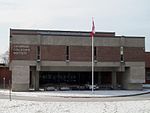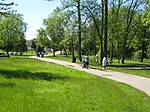Taber Hill
Cemeteries in TorontoFirst Nations history in OntarioFirst Nations sites in TorontoScarborough, TorontoWyandot

Taber Hill, also spelled Tabor Hill, is a Wyandot (Huron) burial mound in Toronto, Ontario. It is located northeast of the intersection of Lawrence Avenue and Bellamy Road in Scarborough. It is estimated to date from the 14th century and contain the skeletons of over 500 Huron/Wendat. It is believed to be the only First Nations ossuary protected as a cemetery in Canada.
Excerpt from the Wikipedia article Taber Hill (License: CC BY-SA 3.0, Authors, Images).Taber Hill
Indian Mound Crescent, Toronto Scarborough
Geographical coordinates (GPS) Address Nearby Places Show on map
Geographical coordinates (GPS)
| Latitude | Longitude |
|---|---|
| N 43.759 ° | E -79.235 ° |
Address
Indian Mound Crescent 7
M1H 1S2 Toronto, Scarborough
Ontario, Canada
Open on Google Maps









